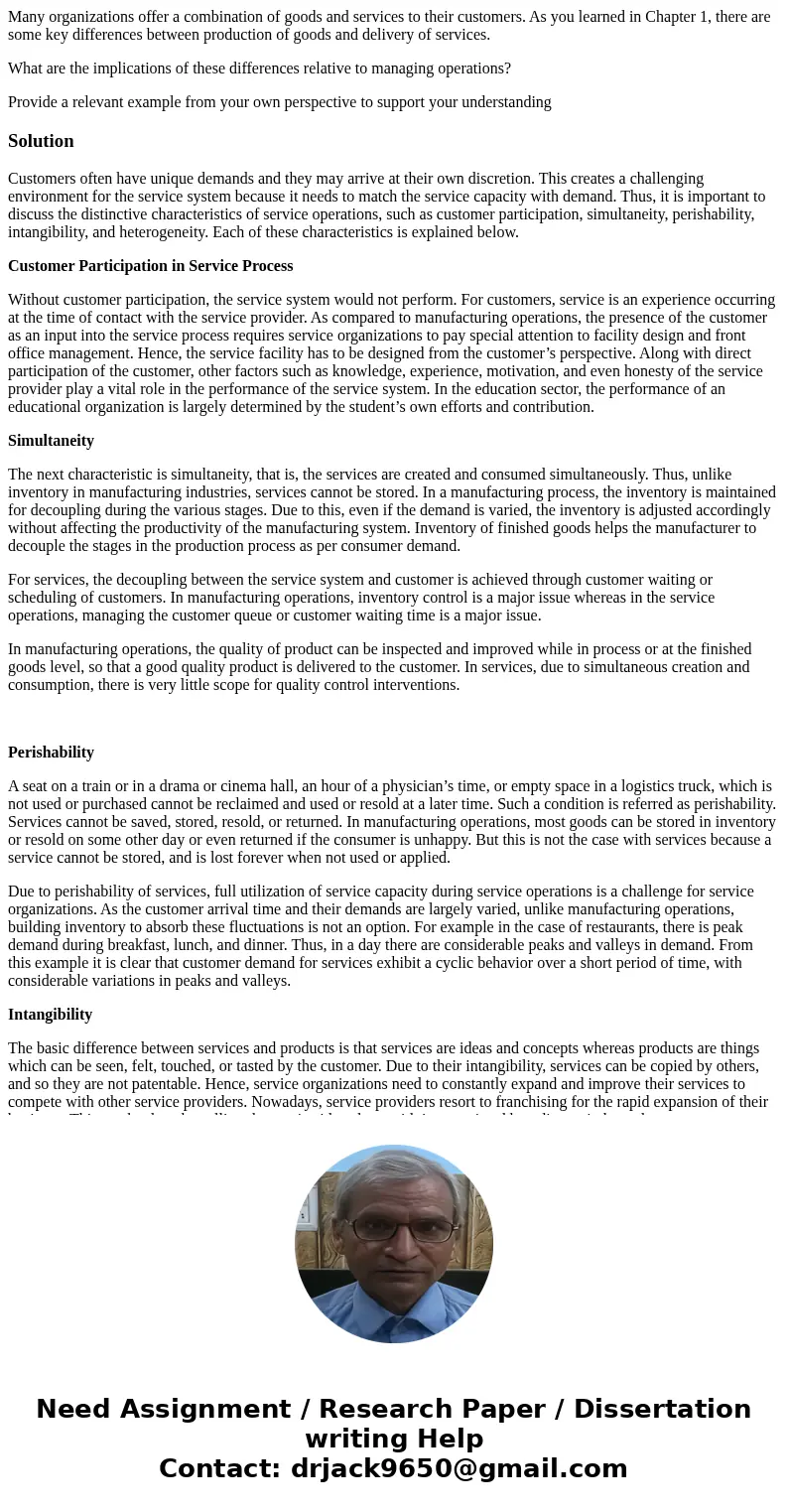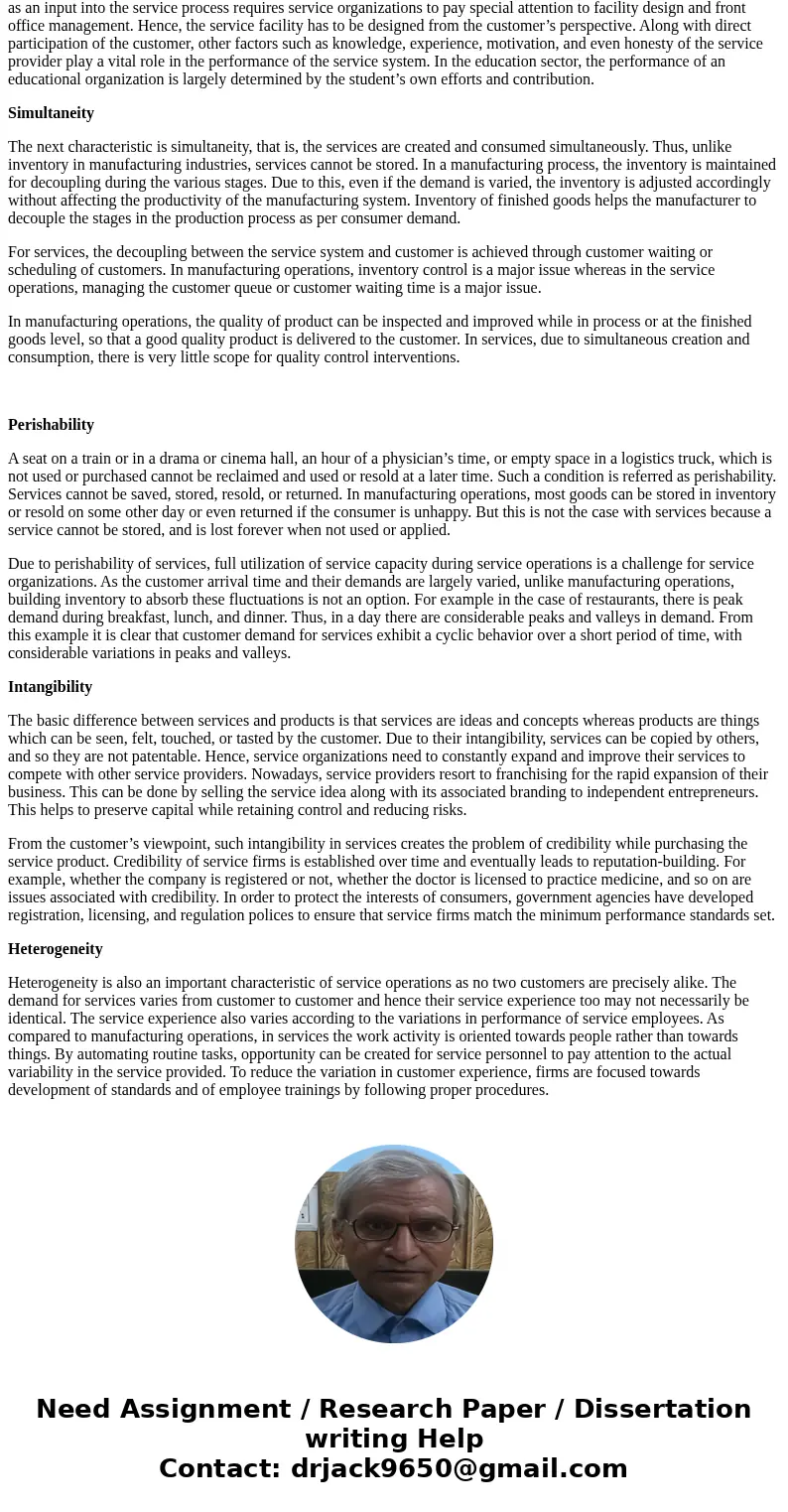Many organizations offer a combination of goods and services
Many organizations offer a combination of goods and services to their customers. As you learned in Chapter 1, there are some key differences between production of goods and delivery of services.
What are the implications of these differences relative to managing operations?
Provide a relevant example from your own perspective to support your understanding
Solution
Customers often have unique demands and they may arrive at their own discretion. This creates a challenging environment for the service system because it needs to match the service capacity with demand. Thus, it is important to discuss the distinctive characteristics of service operations, such as customer participation, simultaneity, perishability, intangibility, and heterogeneity. Each of these characteristics is explained below.
Customer Participation in Service Process
Without customer participation, the service system would not perform. For customers, service is an experience occurring at the time of contact with the service provider. As compared to manufacturing operations, the presence of the customer as an input into the service process requires service organizations to pay special attention to facility design and front office management. Hence, the service facility has to be designed from the customer’s perspective. Along with direct participation of the customer, other factors such as knowledge, experience, motivation, and even honesty of the service provider play a vital role in the performance of the service system. In the education sector, the performance of an educational organization is largely determined by the student’s own efforts and contribution.
Simultaneity
The next characteristic is simultaneity, that is, the services are created and consumed simultaneously. Thus, unlike inventory in manufacturing industries, services cannot be stored. In a manufacturing process, the inventory is maintained for decoupling during the various stages. Due to this, even if the demand is varied, the inventory is adjusted accordingly without affecting the productivity of the manufacturing system. Inventory of finished goods helps the manufacturer to decouple the stages in the production process as per consumer demand.
For services, the decoupling between the service system and customer is achieved through customer waiting or scheduling of customers. In manufacturing operations, inventory control is a major issue whereas in the service operations, managing the customer queue or customer waiting time is a major issue.
In manufacturing operations, the quality of product can be inspected and improved while in process or at the finished goods level, so that a good quality product is delivered to the customer. In services, due to simultaneous creation and consumption, there is very little scope for quality control interventions.
Perishability
A seat on a train or in a drama or cinema hall, an hour of a physician’s time, or empty space in a logistics truck, which is not used or purchased cannot be reclaimed and used or resold at a later time. Such a condition is referred as perishability. Services cannot be saved, stored, resold, or returned. In manufacturing operations, most goods can be stored in inventory or resold on some other day or even returned if the consumer is unhappy. But this is not the case with services because a service cannot be stored, and is lost forever when not used or applied.
Due to perishability of services, full utilization of service capacity during service operations is a challenge for service organizations. As the customer arrival time and their demands are largely varied, unlike manufacturing operations, building inventory to absorb these fluctuations is not an option. For example in the case of restaurants, there is peak demand during breakfast, lunch, and dinner. Thus, in a day there are considerable peaks and valleys in demand. From this example it is clear that customer demand for services exhibit a cyclic behavior over a short period of time, with considerable variations in peaks and valleys.
Intangibility
The basic difference between services and products is that services are ideas and concepts whereas products are things which can be seen, felt, touched, or tasted by the customer. Due to their intangibility, services can be copied by others, and so they are not patentable. Hence, service organizations need to constantly expand and improve their services to compete with other service providers. Nowadays, service providers resort to franchising for the rapid expansion of their business. This can be done by selling the service idea along with its associated branding to independent entrepreneurs. This helps to preserve capital while retaining control and reducing risks.
From the customer’s viewpoint, such intangibility in services creates the problem of credibility while purchasing the service product. Credibility of service firms is established over time and eventually leads to reputation-building. For example, whether the company is registered or not, whether the doctor is licensed to practice medicine, and so on are issues associated with credibility. In order to protect the interests of consumers, government agencies have developed registration, licensing, and regulation polices to ensure that service firms match the minimum performance standards set.
Heterogeneity
Heterogeneity is also an important characteristic of service operations as no two customers are precisely alike. The demand for services varies from customer to customer and hence their service experience too may not necessarily be identical. The service experience also varies according to the variations in performance of service employees. As compared to manufacturing operations, in services the work activity is oriented towards people rather than towards things. By automating routine tasks, opportunity can be created for service personnel to pay attention to the actual variability in the service provided. To reduce the variation in customer experience, firms are focused towards development of standards and of employee trainings by following proper procedures.


 Homework Sourse
Homework Sourse